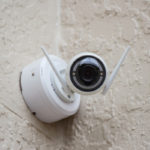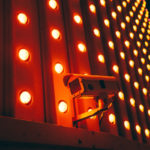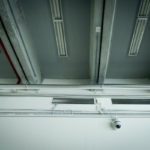Pros & Cons Of Public Security Cameras
There is much debate on whether or not surveillance cameras should be installed in public places such as airports, schools, libraries, and stores. The line between privacy and security is thin and both sides can be argued.
Although so may feel like public surveillance is an invasion of privacy, laws that prohibit surveillance in public places are few and far between, and may be limited to geographical areas. For example, in New York, police may only use video surveillance footage as part of an investigation into the alleged criminals after obtaining a warrant from local authorities.
And remember, placing cameras in areas where an individual has a reasonable expectation of privacy (ex. bathrooms, changing rooms) is always prohibited.
Let’s look at the different pros and cons of public surveillance.
Pro: Increase Public Safety
Just like surveillance on our private property improves our home security, surveillance in public areas increases public safety. Public surveillance can aid in keeping you safe when you are out and about.
Public security cameras can keep an eye out for crimes as well as act as a deterrent. For example, if suspicious individuals are seen in an area, authorities may be able to get ahead of the situation and possibly move innocent bystanders out of harm’s way.
Pro: Reduce Crime Rate
According to statistics, after security cameras are installed, crimes rates drop. For example, crime rates in Humboldt Park dropped 20% after video surveillance was implemented. As previously mentioned, the presence of security cameras act as a deterrent as criminals do not want to risk getting caught on camera.
Pro: Helps Catch Criminals
For crimes committed where video surveillance is present, the chance of catching criminals is much higher. With advanced technology like facial recognition, security cameras may be able to better identify criminals, helping authorities to track them down. Also, these images and information may be shared with the public to help spread the word. It may be difficult to obtain eyewitness accounts, but with security cameras, you often have video evidence of the events that transpired.
Pro: Provide Evidence & Gather Clues
Along the same lines, surveillance footage can be used as evidence in the courtroom. On the other hand, video footage may also help to prove a person’s innocence. Either way, recordings of public areas can help provide clues to solve crimes, and may even provide solid evidence for criminal cases.
Pro: Convenience
Convenience comes in the form of traffic cameras. Surveillance cameras at stoplights help to prevent drivers from speeding through a red light, while security cameras installed on streets and freeways can help to monitor traffic conditions in real-time.
Con: Easily Abused
Unfortunately, this helpful technology can be easily abused. For example, information collected from public cameras can potentially be used as a form of blackmail. Another example is voyeurism and stalking. To combat these issues, strict regulations on public surveillance must be put into place.
Con: Doubts About Effectiveness
In addition, many people doubt the effectiveness of public surveillance. While statistics may show that crimes and incident rates have decreased, security cameras are not as effective when it comes to horrific acts such as terrorism.
Con: Expensive
The cost of public security cameras is another issue. Since many doubt the effectiveness, they feel that public surveillance systems are a waste of money. They argue that high maintenance and costs of these systems is not justified by their limited results.
As you can see, both sides have valid arguments. It is a matter of whether the pros outweigh the cons or vice versa. For the most part, public surveillance has been working for our benefit. Feel free to share your thoughts on the matter with us and your peers on Facebook, Twitter, LinkedIn, and Pinterest.
Please call us at 888-203-6294 if you have any questions regarding our security cameras or installation services, or to request a free quote! You can also visit us online at SecurityCamExpert.com, where you’ll find more information about our products and service. We are happy to help you protect yourself and your loved ones.
Video Surveillance Tricks
Surveillance systems installed at your home or business help to enhance your security by allowing you to keep any eye on your property. They can aid in keeping your loved ones safe, as well as potentially deter criminals from targeting you. And after installation, there are ways to make the most of your surveillance system. Review these tricks to enhance your security.
- Learn The Ins & Outs
Security cameras have different features, so it is important that you choose one that suits your needs. It is also imperative that you learn what your surveillance cameras can do by reading manuals and watching tutorials as necessary.
- Get The Mobile App
Most surveillance systems have an accompanying app which allows you to access your feed and manage your system remotely, as well as provide alerts. Without it, you miss out on these great opportunities to enhance your security.
- Register For E-Mail Alerts
When motion or suspicious activity is detected, you will be notified via e-mail which may be accompanied by video footage.
- Register For Text Alerts
For even faster access, sign up for text alerts. You’ll get essentially the same alert you would via e-mail, but in a text.
- Choose The Right Cameras
As mentioned, it is important to choose cameras with the right features and functions that will cater to your specific surveillance needs. For example, night vision cameras are great for areas that need around the clock monitoring, and day/night cameras are great for outdoor use where lighting can vary. There are a multitude of security cameras on the market with a variety of features so you are sure to find the ones that suit your needs.
- Petsit & Babysit
Indoor security cameras can give you peace of mind when it comes to pets and older children who may be home alone.
- Understand Privacy Mode
If you want to record but don’t want the recordings to be visible remotely, you can turn on privacy mode.
- Set Scheduled Times
Rather than setting your security camera on motion detection only, you can set the times you want your system to record. You can watch the footage in real-time or at a later date, either on the web or your mobile device.
- Manage Your Cameras Remotely
As mentioned, you can manage your camera system remotely via an app installed on a PC or smart device.
Share your own surveillance tips and tricks with us on Facebook, Twitter, LinkedIn, and Pinterest.
If you need helping choosing a new security camera system for your home or business, please feel free to contact us! You can browse our stock online or give us a call 888-203-6294 to speak with one of our representatives directly. Your security is our priority and we are always happy to help.
Campus Surveillance & Security Measures
As students head back to school, it is important to consider campus security and how we can keep our children safe. Surveillance camera systems on campus are important assets in helping to make schools safer – here’s why.
Deter Crime
The mere presence of security cameras is known to reduce criminal activity. Bottom line, surveillance poses a risk of getting caught and criminals simply don’t want that.
Prevent Vandalism & Theft
Because schools and campuses have predictable off hours, it is easy for vandals and thieves to target them. However, strategically placed security cameras and alarm systems can help to prevent this type of activity.
Eliminate Unauthorized Intruders
By monitoring and evaluating surveillance footage, you can more easily identify persons that do not belong in the area.
Monitor Entrances, Exits & Corridors
Since foot traffic is high during the school day, most entrances and exits must remain unlocked, making them vulnerable to intruders. Keeping an eye on these, as well as hallways and corridors, will help identify who is or has been on school property as well as what they did or are doing there.
Visitor Monitoring
Any visitor can pose a potential threat, and surveillance camera footage can keep track of that. Having eyes on the situation allows for quick response if any misbehavior or misconduct occurs.
We carry a wide variety of security cameras and surveillance packages for your home, school, or business. Visit us online at SecurityCamExpert.com to browse our stock, or call 888-203-6294 to schedule a site survey or request a free quote. You can also connect with us on Facebook, Twitter, LinkedIn, and Pinterest.
Security Cameras: Analog Versus IP
Whether you are looking to upgrade your analog security cameras, or you are shopping for a new security system, it’s important to know the differences between analog and IP cameras to determine which type will best suit your needs. There are advantages and disadvantages to both types of cameras – be sure to review these before making a final decision.
Advantages of Analog Cameras
- Cost: If you have an existing analog system, it is obviously cheaper to stick with it. If you are on the market for security system, analog cameras are often significantly cheaper, and if you need to add more cameras, analog is likely the more cost-effective option.
- Availability: You will have an easier time finding vendors and installers for analog system since they have been around for years and are fairly simple to install.
- Simplicity: Speaking of, analog cameras offer an ease of use that make them very user friendly. The cameras send recordings to a DVR (digital video recorder), which then converts the analog to digital and stores it. And managing and using DVRs is simple as well.
- Technology: The technology used with analog has greatly improved over the years. High definition (HD) analog offers improved picture quality and resolution.
Disadvantages Of Analog Cameras
- Frame Rate & Image Quality: Analog cameras have a lower frame rate than IP cameras, so if you’re monitoring an area with lots of motion or need extreme detail, they are not ideal. Analog images are not as sharp and may appear grainy or blurry, and you cannot digitally zoom as you can with IP cameras. However, depending on the type of surveillance you need in a given area, high frame rate may not be a crucial factor.
- Less Coverage: Covering a certain amount of area may require more analog cameras than it would with IP cameras.
- More Cables: Analog cameras require a power cable and a DVR cable, whereas IP cameras only require one cable.
- No Encryption: The lack of encryption leaves you at risk for a hacker to potentially access your information or replace your signal with an outside one.
Advantages of IP Cameras
- Multiple Sensors: IP cameras can cover a larger area because they can contain as many as three to four cameras in one. All of these become one signal and are transferred through one cable to your system.
- Cost: Early on, the price difference between analog and IP cameras were drastic. Luckily, the prices have gone down and many IP cameras boast cost-effective prices. Also, because fewer IP cameras are required to the do same job as multiple analog cameras, your investment can be more beneficial.
- Installation: IP cameras only require one cable per camera and allow you to focus and zoom remotely. So long as your camera is installed at the right angle, you can easily control and manage your video feed from your workstation.
- Resolution: IP cameras have better image quality than analog cameras, and are available with different resolutions and aspect ratios to suit your needs.
- Intelligence & Analytics: IP cameras offer the ability to compress and store videos as well as provide a variety of different analytics. Some types of analytics you can program include motion or smoke detection, people counting, color tracking, and more.
- Security: IP video is encrypted and authenticated to ensure secure transmission.
- Equipment: IP camera systems require less equipment (analog requires more cables as well as an encoder and decoder).
- Open Platform: IP cameras are essentially universal and make it easy to add new features and functions to your system.
Disadvantages Of IP Cameras
- Cost Of Initial Set-Up: Upfront pricing may be more initially, but it can pay off in the long run. Once set up, it is must easier to tailor and scale your system as needed in the future.
- Storage: Since IP cameras produce higher resolution images, they generate larger files which require more storage space.
- Learning Curve: There is a user interface that end users may need to get accustomed to. While it is mostly intuitive, there is a certain level of technicality that needs to be learned.
From Analog To IP
If you are making the switch from analog to IP, here are some helpful tips.
- Bring in an independent consultant. You may have unrealistic expectations for your cameras that do not fit their capabilities, and an impartial party can help you see that.
- Replace as you can. If budget is not an issue, switching out your entire analog system for IP cameras at once is feasible. However, many of us have limited budgets, so replacing a few cameras at a time may be more practical. In doing so, you are creating a hybrid system, which supports both analog and IP cameras. Start by replacing the most important cameras to IP and create a plan for switching the rest of the analog cameras as they run their course.
- Find an installer/vendor that specializes in IP systems. It is beneficial to work with someone who understands the technology and networking of the system and is capable of installing your system properly and advising you on how to use it.
- Discuss what you really need. Just because IP cameras provide a wide range of capabilities does not mean you necessarily need all of them. Determine what you want your cameras to accomplish, what you really need, and how your budget can help you carry out your vision.
- Revisit your security plan. When making the switch, it is the ideal time for you to revise your security plans and reevaluate your approach.
What other transition tips can you think of? Share with us on Facebook, Twitter, LinkedIn, and Pinterest.
If you need help choosing IP security cameras, or would like to request a site survey or free quote, please call us at 888-203-6294. You can also browse our stock of quality security cameras online at SecurityCamExpert.com.
What You Need To Know About Cloud Cameras
What are cloud cameras and why should you invest in them?
A cloud-based security camera, or cloud camera, is a security camera that is closely related to the IP camera. Both cloud and IP cameras connect to the internet, however, with cloud cameras, you need not assign IP addresses to each camera. Cloud cameras make it simple – all they need is a power cord and an Ethernet cable and you’re set. Cloud cameras will come with software or an app that enables streaming and remote camera management via smart device or computer.
On the upside, cloud cameras offer excellent benefits for users. First of all, these cameras are extremely easy to set up as they essentially plug-and-play. They are compact, affordable and accessible.
Cloud-based cameras also allow you to access your video feed virtually anytime from any place. While IP cameras can also provide this benefit, they require a bit more extensive set up to ensure proper performance and security.
In addition, cloud cameras boast automatic updates, device software improvements, and security vulnerability patching. Maintaining any additional hardware and software is no longer a worry.
With these advantages come some disadvantages. Cloud cameras come with monthly fees and limited functionality depending on how much you are willing to pay. And your provider may raise prices at any time, thus you must pay the higher price or purchase a different camera.
Privacy concerns and security risks are another factor, as your video feed is available on an external server. Also, because your cloud camera will be constantly sending data over the internet, it can slow down connection for other internet activities. For those in areas with slow service or data caps, cloud cameras may not be a feasible option.
The important thing to remember is that there are numerous security cameras with different features on the market. You should evaluate your needs and research different types of cameras to determine which type is right for you. If you need some help or have any questions, please feel free to contact us at 888-203-6294. You can also browse our selection of top quality security cameras at cost-effective prices online at SecurityCamExpert.com. Connect with us on Facebook, Twitter, LinkedIn, and Pinterest.
Types Of Night Vision Security Cameras
Security cameras with night vision are crucial for monitoring your property around the clock. Night vision technology allows you to capture usable images in low to no light conditions. This is extremely helpful as most burglars prefer to lurk around in the darkness.
Whether you are safeguarding your home or business, night vision security cameras are a great investment. Before you start shopping, review the different types of night vision to decide which will work best for your surveillance needs.
Low Light Night Vision
Low light night vision is also known as image intensification as it relies on image intensification technology to deliver colored night vision in very low light. Please note that in order to produce a color image, these security cameras need some available light.
Low light night vision cameras use an image intensifier which is a vacuum-tube based device. Electrons are emitted through a vacuum tube when the light strikes a charged photocathode plate. These electrons then strike the microchannel plate that cause the image screen to illuminate with a picture in the same pattern as the light that strikes the photocathode (on a frequency that the human eye can see). The image is said to be “intensified” because the output visible light is now brighter than the incoming light.
Benefits
- Despite needing some visible light in order to record, low light night vision cameras outperform IR night vision cameras.
- These are the only security cameras that can produce a color image in low light level conditions.
- You can find these cameras at cost-effective prices.
Infrared (IR) Night Vision
These days, most security cameras come with built-in infrared LEDs to provide night vision in low light or no light conditions. One of the most important features of these cameras is the infrared cut filter or infrared cut removable.
The IR cut filter is a mechanical shutter design – it is a piece placed between the lens and the image sensor, controlled by a motor or an electromagnet. These are used with color CCD or CMOS cameras to produce accurate color images.
When IR cut filter is activated, it will block IR light and allow only visible light to pass through. When the ICR is turned off, IR light will be allowed and images will turn into black and white mode.
If it’s controlled by a light sensor, at twilight, it simply sends a remove signal to the IR cut filter so that more light could reach the image sensor of the camera, thus, a black and white image is produced.
It is important to know that IR security cameras can be affected by glass reflection or window glare at night. Your video may be washed out due to overexposure of lights at night. If necessary, turn off the IP LEDs and any other LED indicators on your security camera.
Benefits
- Infrared night vision cameras can record in pitch black condition without additional light.
- These cameras are the most inexpensive, use less energy, and are very efficient.
Thermal Night Vision
Thermal night vision cameras have a unique lens that allows IR energy to pass through it. The focus light then hits a sensor that scans the information and draws from several thousand points in the field of view. This process creates a thermogram (an intricate temperature pattern) which quickly develops and then transforms into electric impulses, which are directed to signal processing unit that translates the information into data for the visual.
Created image displays as various colors that correlate to the amount of IR energy emitted. Instead of intensifying light, thermal night vision uses heat and can see no matter the light level. Thus, even in total darkness and poor weather conditions, thermal imaging technology allows users to detect and see at great distances.
Benefits
- Thermal cameras are the only solution to address a visible image contrast to see at night.
- As mentioned, these cameras are completely immune to smoke, dust, and anti-CCTV surveillance devices (visor glasses, infrared laser glasses).
- Government agencies, security companies, and large corporations rely on thermal security cameras for many security applications because they eliminate false alarms.
For a wide selection of quality security cameras, surveillance system packages, and more, please visit SecurityCamExpert.com or call 888-203-6294. You can also connect with us on Facebook, Twitter, LinkedIn, and Pinterest.
Summer Water Safety
Water safety is especially important in the summertime, when beach and pool days and lake trips are abundant. Keep children and loved ones safe by heeding these essential water safety tips.
General Tips
- Look for U.S. Coast Guard approved labels.
Lifejackets should have labels that read “US Coast Guard Approved” or “USCG approved,” otherwise you can assume they are not safe. As your child grows, their lifejacket should meet their new weight, and should be replaced when rips, tears, or fraying straps are present. And remember, any items filled with air (arm floaties, rafts) are not considered life saving devices. - Assign adult, non-distracted Water Watchers.
At least one adult, non-distracted Water Watcher should be monitoring children in and around water at all times with no distractions (conversations, cell phone, reading, etc.). The Water Watcher should always be within reach and is usually safest in the pool with the children. For social gatherings, 10-15 minute Water Watcher shifts are recommended. And remember, if a child goes missing, always check the pool/water first. - Take family CPR lessons.
Learning CPR can make a difference while waiting for emergency personnel to arrive. - Schedule water safety & swim lessons.
Drownings and near-drownings are much more likely to occur with children that don’t know how to swim or are being supervised by adults that don’t know how to swim. While there are still risks with children who know how to swim, knowing how to and practicing proper water safety can significantly reduce the risks.
Open Water
- Have a safety plan in place.
Whether you’re at the lake or the beach, you should implement a safety plan before anyone gets anywhere near the water. The “Toe In/Vest On” policy is recommended, which basically means that if a toe is in the water, a life jacket must be on.
- Know the water conditions.
Conditions in lakes and oceans can vary on a daily basis. From clear to murky and calm to rough waters, it’s important to know the conditions before getting in.
Pools
- Install four-sided fences with self-latching gates.
Implementing this safety mechanism could prevent 50-90% of childhood drowning and near-drowning accidents. The fence should at least be 4 feet (ideally 5 feet) high with a self-closing gate that only opens out. In addition, pool gates should have child proof locks and remain locked when the pool is not in use. If you have pool and/or spa covers, they should be strong enough to support the weight of multiple children. Any doggie doors that have direct access to the pool area should be rerouted as well. - Create and follow all pool rules.
Your guest should understand your expectations about watching children in the water and abide by your pool rules. You may even consider creating a Water Watcher schedule so that non-distracted adult Water Watchers can work in 10-15 minute shifts. - Use pool/door/child alarms.
Doors and windows that open directly to the pool area should be equipped with alarms. These alarms can alert you when children may be going outside to the pool. Furthermore, pool surface alarms can alert you when anyone or anything falls into the pool. For added security, you can even put an alarm on your child that is activated when they are submersed. - Update pool drains and cleaning systems.
Pool drains and other cleaning equipment have powerful suction that could create a dangerous situation and should be avoided. Because swimsuit straps, hair, and other items can easily get caught, safety drain covers should be used as a prevention method.
Share your own water safety tips with us on Facebook, Twitter, LinkedIn, and Pinterest.
Keep an eye on your pool and property with quality security cameras from SecurityCamExpert.com. Let us help you choose the right surveillance system to suit your needs and we can take care of the installation, too! To learn more about our products and services, please call 888-203-6294.
Avoid These Surveillance Mistakes
Installing a home surveillance system can be rewarding, providing you a sense of security and peace of mind. However, the process of choosing, installing and using the right cameras is a delicate task. It’s important to evaluate your needs, understand what features will help you accomplish your goals, and execute installation and use correctly. Avoid errors in the process by reviewing these common security camera mistakes.
- Mistake: Forgetting to secure indoor and outdoor surveillance cameras.
If you fail to secure your surveillance cameras, they can be susceptible to tampering and vandalism. To keep your equipment safe, install your cameras at least 9 feet above the ground. You may also want to consider investing in vandal proof and weather proof housing, especially for outdoor cameras. - Mistake: Thinking cameras are able to multitask.
They cannot. When you are installing your security cameras, you must think of the task you want your camera to perform and where to place it. Prepare a diagram for your home security system so you can plan out camera placement. This will also allow you to figure out how many and what type of cameras you need for optimum security. - Mistake: Placing cameras at the highest point.
While this tactic will give you a larger view, you will not a get a detailed look at any person’s features, making it impossible to identify potential criminals. You may want to try a PTZ (pan/tilt/zoom) security camera which allows you to view large areas while enabling zoom for a more detailed look without compromising quality. - Mistake: Using cameras without Wide Dynamic Range at doorways and windows.
Wide Dynamic Range (WDR) plays a big role when part of an image is extremely dark but another part is bright. Since lighting conditions indoors and outdoors can vary drastically, this feature is especially essentials for cameras near windows and doorways. - Mistake: Failing to provide enough lighting.
If you require night time monitoring, you should invest in night vision security cameras. However, if your camera does not have night vision, be sure to provide enough lighting so that your cameras can record clear footage. Remember, putting cameras too close to bright lights will cause the picture to be disrupted. Also, if an outdoor camera is pointing to direct sunlight, this will cause stripes in the images.
Have any security mishaps or tips to share? Connect with us on Facebook, Twitter, LinkedIn, and Pinterest.
SecurityCamExpert.com offers quality surveillance equipment along with expert installation! Visit us online to browse our stock or call 888-203-6294 to request a FREE quote or schedule a site survey.
Should You Install Indoor Security Cameras?
Security cameras offer home and business owners peace of mind by allowing vigilance over properties. As a homeowner, installing an indoor security camera can help you check in on pets or simply watch over your home while you’re away. Although these benefits are appealing, there are a few things to consider before deciding on installing indoor security cameras.
Worries
It’s true that security cameras are meant to put your worries at ease, but at the same time, they can feed your anxiety. Because you can check in on things at any time, you may find yourself obsessively monitoring your feed.
To minimize this, set up a camera with motion detection so that it may alert you when there is activity. If you have pets, you can filter out their activity so that you are not inundated with false alarms.
Hackers
With internet-connected security cameras, you run the risk of hackers gaining access to your camera. This type of attack is much more common with cameras that have little to no built-in security. Luckily, there are ways to combat these risks. First, you should invest in well-know, higher quality security cameras that have better built-in security. Once you have chosen a camera, change any default logins and use strong, hard-to guess passwords. Also, be sure that your home Wi-Fi network is also highly protected.
Pets
As previously mentioned, indoor security cameras provide an easy way to keep an eye on your pets when you’re away. But when it comes to motion detection, they can easily trigger false alarms. Once you adjust your settings to accommodate pet activity, the security camera can be a great help. Whether you’re missing your pet while you’re away or if you’re working at home, security cameras allow you to see what they are up to.
Valuables
Of course, security cameras are meant to keep you safe from burglars. Their presence alone can help to deter criminal behavior. But in the case that it does not, it can provide useful footage that can be submitted as evidence.
Do you have security cameras installed at your home or business? How have they helped? Share your experiences with us on Facebook, Twitter, LinkedIn, and Pinterest.
For a great selection of quality IP and HD security cameras for your home or business, please visit SecurityCamExpert.com or call 888-203-6294 today!
Benefits Of Dome Security Cameras
You have likely encountered dome security cameras when out in public, whether you’re shopping at the store or visiting the bank. They are small, dome-shaped objects attached to ceilings or walls. The dome of the camera is usually heavily tinted, and they are often vandal proof, weather proof and have built-in infrared LEDs. If you are considering installing security cameras, here are a few reasons why dome cameras are a smart choice.
Visual Deterrent
Part of the allure of security cameras is that their presence is effective in deterring bad behavior. With dome cameras, they are inconspicuous enough to blend with décor, however, the heavy tint on the dome is relatively hard to miss. Whether or not an incident occurs, you will have video footage to review and potentially use as evidence.
Ambiguity
As mentioned, the heavily tinted dome not only protects the camera, but it makes people question which direction the camera is aimed. People may also be unsure of whether or not the camera moves to monitor a wider area. This ambiguity helps to further deter any criminal acts. Some may opt to install dummy dome cameras as a low-cost alternative. Remember that it is not guaranteed that a dome camera will prevent all criminal activity, thus, it is better to install a real dome security camera.
Variety
Of security cameras, dome cameras are relatively inexpensive and are available in a wide variety of styles. As mentioned, if you are installing your cameras outdoors, you may want to look for weather proof and vandal proof dome cameras. This will ensure that your cameras can withstand harsh environmental elements, as well as physical damage should someone attempt to tamper with your security cameras. And if you need around-the-clock surveillance, infrared dome cameras offer night vision, allowing your camera to record in low to no light situations.
If you need help choosing a dome camera, or other security cameras and equipment, please contact us at 888-203-6294. Browse our stock of quality surveillance systems and more online at SecurityCamExpert.com and connect with us on Facebook, Twitter, LinkedIn, and Pinterest.









